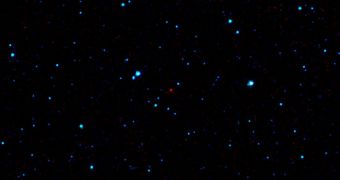NASA's most recently launched telescope, the Wide-field Infrared Survey Explorer, or WISE, has managed to discover its first asteroid, a never-before-seen object dubbed 2010 AB78. Experts managing the mission say that this is but the first such space rock to be identified by the powerful infrared observer, and that thousands of others are expected to be identified during the full duration of the spacecraft's mission. Additionally, millions of new stars and galaxies are also believed to be just waiting to be discovered by the four light detectors aboard WISE.
The 2010 AB78 object was discovered on January 12, and was immediately cataloged as a near-Earth object, or NEO. The NASA telescope identified the fact that the space rock appeared to be moving, as opposed to a background of seemingly static stars. The data was promptly sent back to the Jet Propulsion Laboratory (JPL), in Pasadena, California, which is in charge of managing the mission for NASA's Science Mission Directorate, in Washington DC. Experts here were able to confirm the finding by looking at the asteroid with the 2.2-meter (88-inch) visible-light telescope that the University of Hawaii operates near the summit of Mauna Kea.
“The asteroid is currently about 158 million kilometers (98 million miles) from Earth. It is estimated to be roughly 1 kilometer (0.6 miles) in diameter and circles the Sun in an elliptical orbit tilted to the plane of our solar system. The object comes as close to the Sun as Earth, but because of its tilted orbit, it is not thought to pass near our planet. This asteroid does not pose any foreseeable impact threat to Earth, but scientists will continue to monitor it,” the JPL team says in a statement on its website. One of the main targets of WISE's investigation is the Main Belt, a field of asteroids that lies between the orbit of Mars and Jupiter.
Previous investigations of the area have revealed numerous objects there, but with the new observatory's abilities, some 100,000 new objects are about to be discovered, the JPL team estimates. Hundreds of NEO are expected to be found as well, in addition to millions of galaxies. The spacecraft will perform one and a half full sweeps of the sky, observing the entire Universe in four infrared wavelengths. The mission was competitively selected under NASA's Explorers Program, which is managed by the Goddard Space Flight Center (GSFC), in Greenbelt, Maryland, and is partially supported by the US National Science Foundation (NSF).

 14 DAY TRIAL //
14 DAY TRIAL //